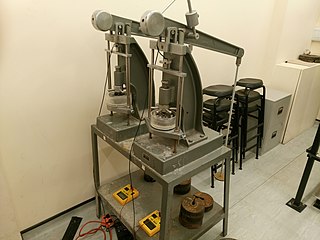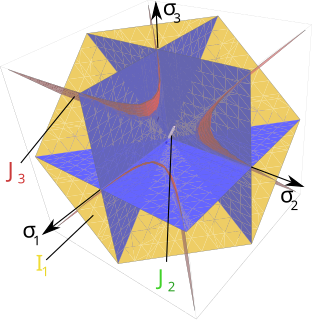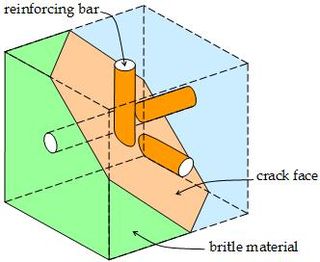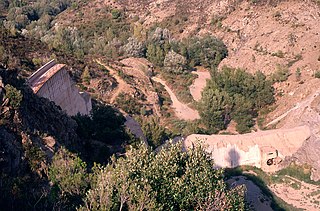This article needs additional citations for verification .(March 2017) (Learn how and when to remove this template message) |
This article may be too technical for most readers to understand. Please help improve it to make it understandable to non-experts, without removing the technical details. (March 2017) (Learn how and when to remove this template message) |

In. soil mechanics, consolidation refers to the process by which soil changes volume gradually in response to a change in pressure. This happens because soil is a two-phase material, comprising soil grains and pore fluid, usually groundwater. When soil saturated with water is subject to an increase in pressure, the high volumetric stiffness of water compared to the soil matrix means that the water initially absorbs all the change in pressure without changing volume, creating excess pore water pressure. As water diffuses away from regions of high pressure due to seepage, the soil matrix gradually takes up the pressure change and shrinks in volume. The theoretical framework of consolidation is therefore closely related to the diffusion equation, the concept of effective stress, and hydraulic conductivity.

Soil mechanics is a branch of soil physics and applied mechanics that describes the behavior of soils. It differs from fluid mechanics and solid mechanics in the sense that soils consist of a heterogeneous mixture of fluids and particles but soil may also contain organic solids and other matter. Along with rock mechanics, soil mechanics provides the theoretical basis for analysis in geotechnical engineering, a subdiscipline of civil engineering, and engineering geology, a subdiscipline of geology. Soil mechanics is used to analyze the deformations of and flow of fluids within natural and man-made structures that are supported on or made of soil, or structures that are buried in soils. Example applications are building and bridge foundations, retaining walls, dams, and buried pipeline systems. Principles of soil mechanics are also used in related disciplines such as engineering geology, geophysical engineering, coastal engineering, agricultural engineering, hydrology and soil physics.

Pressure is the force applied perpendicular to the surface of an object per unit area over which that force is distributed. Gauge pressure is the pressure relative to the ambient pressure.

Groundwater is the water present beneath Earth's surface in soil pore spaces and in the fractures of rock formations. A unit of rock or an unconsolidated deposit is called an aquifer when it can yield a usable quantity of water. The depth at which soil pore spaces or fractures and voids in rock become completely saturated with water is called the water table. Groundwater is recharged from and eventually flows to the surface naturally; natural discharge often occurs at springs and seeps, and can form oases or wetlands. Groundwater is also often withdrawn for agricultural, municipal, and industrial use by constructing and operating extraction wells. The study of the distribution and movement of groundwater is hydrogeology, also called groundwater hydrology.
Contents
- History and terminology
- Mechanism
- Consolidation analysis
- Spring analogy
- Primary consolidation
- Secondary consolidation
- Time dependency
- See also
- References
- Bibliography
In the narrow sense, "consolidation" refers strictly to this delayed volumetric response to pressure change due to gradual movement of water. Some publications also use "consolidation" in the broad sense, to refer to any process by which soil changes volume due to a change in applied pressure. This broader definition encompasses the overall concept of soil compaction, subsidence, and heave. Some types of soil, mainly those rich in organic matter, show significant creep, whereby the soil changes volume slowly at constant effective stress over a longer time-scale than consolidation due to the diffusion of water. To distinguish between the two mechanisms, "primary consolidation" refers to consolidation due to dissipation of excess water pressure, while "secondary consolidation" refers to the creep process.

In geotechnical engineering, soil compaction is the process in which a stress applied to a soil causes densification as air is displaced from the pores between the soil grains. When stress is applied that causes densification due to water being displaced from between the soil grains, then consolidation, not compaction, has occurred. Normally, compaction is the result of heavy machinery compressing the soil, but it can also occur due to the passage of (e.g.) animal feet.

Subsidence is the sudden sinking or gradual downward settling of the ground's surface with little or no horizontal motion. The definition of subsidence is not restricted by the rate, magnitude, or area involved in the downward movement. It may be caused by natural processes or by human activities. The former include various karst phenomena, thawing of permafrost, consolidation, oxidation of organic soils, slow crustal warping, normal faulting, caldera subsidence, or withdrawal of fluid lava from beneath a solid crust. The human activities include sub-surface mining or extraction of underground fluids, e. g. petroleum, natural gas, or groundwater. Ground subsidence is of global concern to geologists, geotechnical engineers, surveyors, engineers, urban planners, landowners, and the public in general.
Organic matter, organic material, or natural organic matter (NOM) refers to the large pool of carbon-based compounds found within natural and engineered, terrestrial and aquatic environments. It is matter composed of organic compounds that have come from the remains of organisms such as plants and animals and their waste products in the environment. Organic molecules can also be made by chemical reactions that don't involve life. Basic structures are created from cellulose, tannin, cutin, and lignin, along with other various proteins, lipids, and carbohydrates. Organic matter is very important in the movement of nutrients in the environment and plays a role in water retention on the surface of the planet.
The effects of consolidation are most conspicuous where a building sits over a layer of soil with low stiffness and low permeability, such as marine clay, leading to large settlement over many years. Types of construction project where consolidation often poses technical risk include land reclamation, the construction of embankments, and tunnel and basement excavation in clay.

A building, or edifice, is a structure with a roof and walls standing more or less permanently in one place, such as a house or factory. Buildings come in a variety of sizes, shapes, and functions, and have been adapted throughout history for a wide number of factors, from building materials available, to weather conditions, land prices, ground conditions, specific uses, and aesthetic reasons. To better understand the term building compare the list of nonbuilding structures.

Stiffness is the extent to which an object resists deformation in response to an applied force.
Marine clay is a type of clay found in coastal regions around the world. In the northern, deglaciated regions, it can sometimes be quick clay, which is notorious for being involved in landslides.
Geotechnical engineers use oedometers to quantify the effects of consolidation. In an oedometer test, a series of known pressures are applied to a thin disc of soil sample, and the change of sample thickness with time is recorded. This allows the consolidation characteristics of the soil to be quantified in terms of the coefficient of consolidation () and hydraulic conductivity ().





















